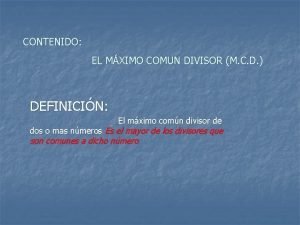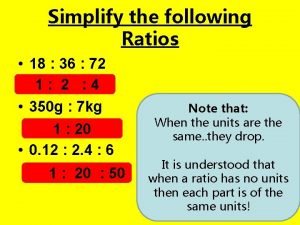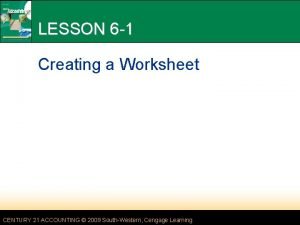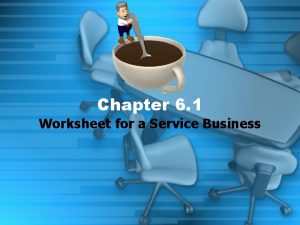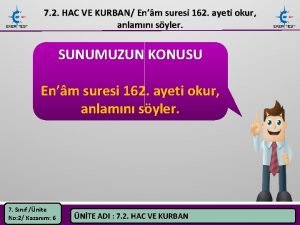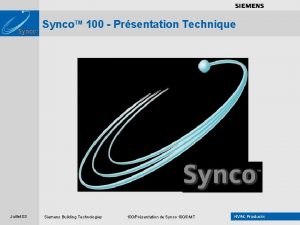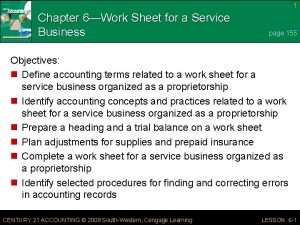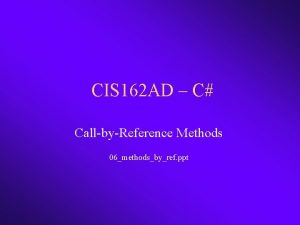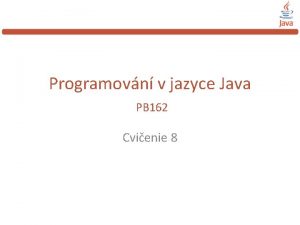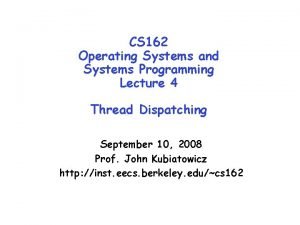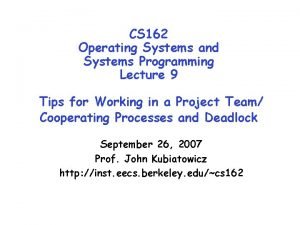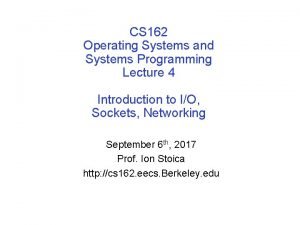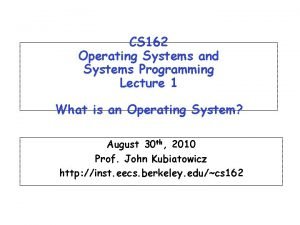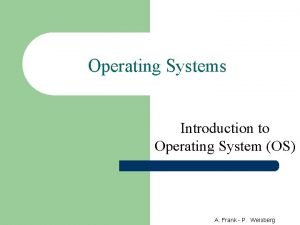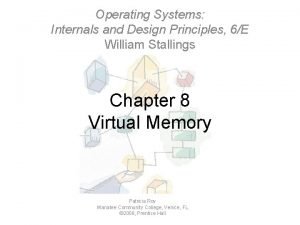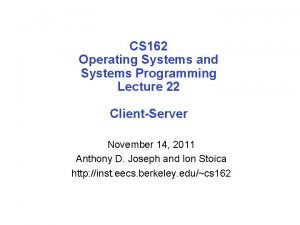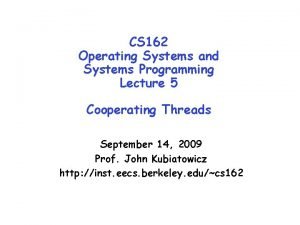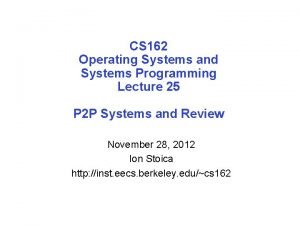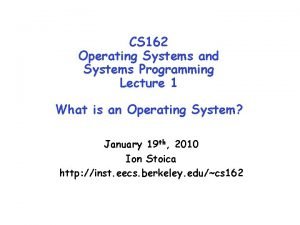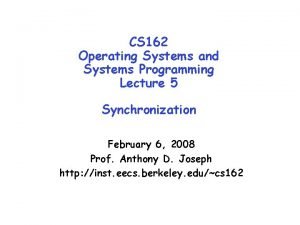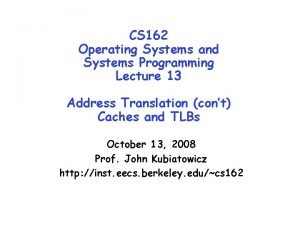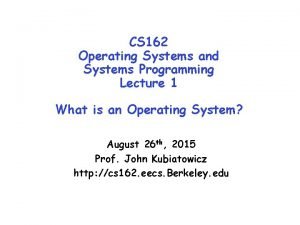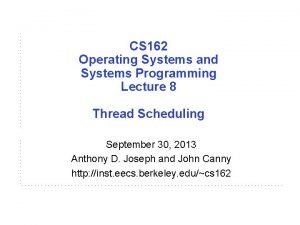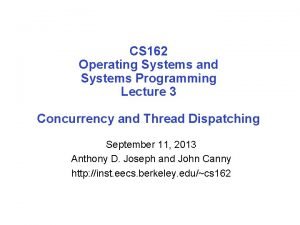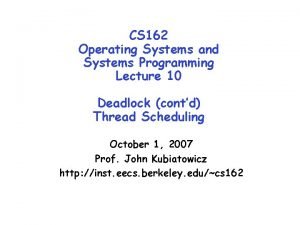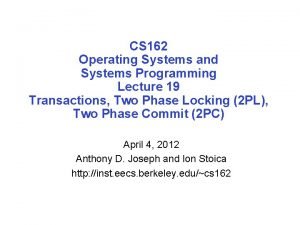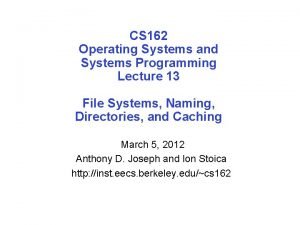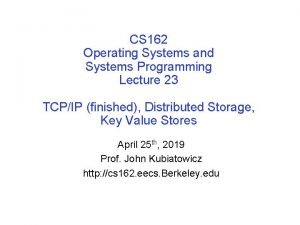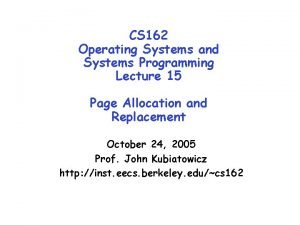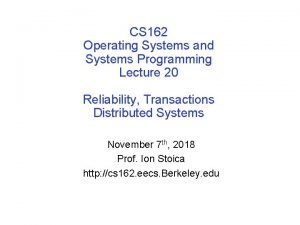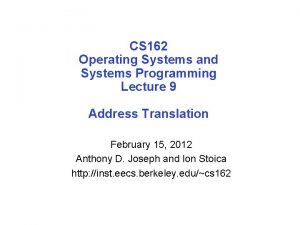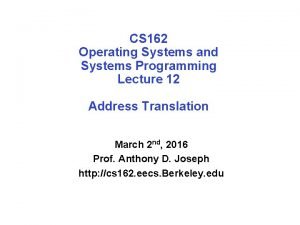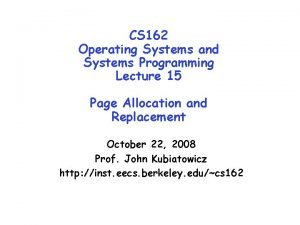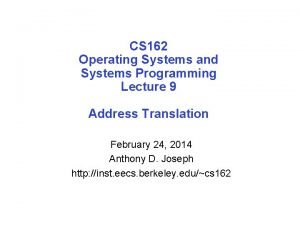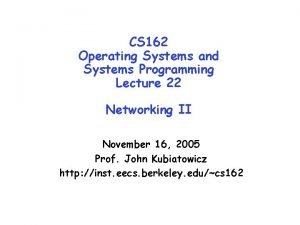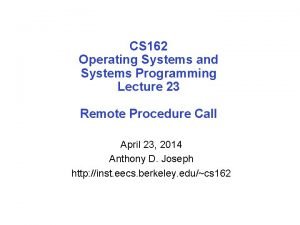CS 162 Operating Systems and Systems Programming Lecture



































- Slides: 35

CS 162 Operating Systems and Systems Programming Lecture 21 Networking April 8, 2010 Ion Stoica http: //inst. eecs. berkeley. edu/~cs 162

Goals for Today • Distributed file systems • Authorization • Networking – – Broadcast Point-to-Point Networking Routing Internet Protocol (IP) Note: Some slides and/or pictures in the following are adapted from slides © 2005 Silberschatz, Galvin, and Gagne Many slides generated from lecture notes by Kubiatowicz. 4/8/10 CS 162 ©UCB Spring 2010 Lec 21. 2

Remote File Systems: Virtual File System (VFS) • VFS: Virtual abstraction similar to local file system – Instead of “inodes” has “vnodes” – Compatible with a variety of local and remote file systems » provides object-oriented way of implementing file systems • VFS allows the same system call interface (the API) to be used for different types of file systems – The API is to the VFS interface, rather than any specific type of file system 4/8/10 CS 162 ©UCB Spring 2010 Lec 21. 3

Network File System (NFS) • Three Layers for NFS system – UNIX file-system interface: open, read, write, close calls + file descriptors – VFS layer: distinguishes local from remote files » Calls the NFS protocol procedures for remote requests – NFS service layer: bottom layer of the architecture » Implements the NFS protocol • NFS Protocol: remote procedure calls (RPC) for file operations on server – Reading/searching a directory – manipulating links and directories – accessing file attributes/reading and writing files • NFS servers are stateless; each request provides all arguments require for execution • Modified data must be committed to the server’s disk before results are returned to the client – lose some of the advantages of caching – Can lead to weird results: write file on one client, read on other, get old data 4/8/10 CS 162 ©UCB Spring 2010 Lec 21. 4

Schematic View of NFS Architecture 4/8/10 CS 162 ©UCB Spring 2010 Lec 21. 5

Authorization: Who Can Do What? • How do we decide who is authorized to do actions in the system? • Access Control Matrix: contains all permissions in the system – Resources across top » Files, Devices, etc… – Domains in columns » A domain might be a user or a group of users » E. g. above: User D 3 can read F 2 or execute F 3 – In practice, table would be huge and sparse! 4/8/10 CS 162 ©UCB Spring 2010 Lec 21. 6

Authorization: Two Implementation Choices • Access Control Lists: store permissions with object – Still might be lots of users! – UNIX limits each file to: r, w, x for owner, group, world – More recent systems allow definition of groups of users and permissions for each group – ACLs allow easy changing of an object’s permissions » Example: add Users C, D, and F with rw permissions • Capability List: each process tracks which objects has permission to touch – Popular in the past, idea out of favor today – Consider page table: Each process has list of pages it has access to, not each page has list of processes … – Capability lists allow easy changing of a domain’s permissions » Example: you are promoted to system administrator and should be given access to all system files 4/8/10 CS 162 ©UCB Spring 2010 Lec 21. 7

Authorization: Combination Approach • Users have capabilities, called “groups” or “roles” – Everyone with particular group access is “equivalent” when accessing group resource – Like passport (which gives access to country of origin) 4/8/10 • Objects have ACLs – ACLs can refer to users or groups – Change object permissions object by modifying ACL – Change broad user permissions via changes in group membership – Possessors of proper credentials get access CS 162 ©UCB Spring 2010 Lec 21. 8

Authorization: How to Revoke? • How does one revoke someone’s access rights to a particular object? – Easy with ACLs: just remove entry from the list – Takes effect immediately since the ACL is checked on each object access • Harder to do with capabilities since they aren’t stored with the object being controlled: – Not so bad in a single machine: could keep all capability lists in a well-known place (e. g. , the OS capability table). – Very hard in distributed system, where remote hosts may have crashed or may not cooperate (more in a future lecture) 4/8/10 CS 162 ©UCB Spring 2010 Lec 21. 9

Revoking Capabilities • Various approaches to revoking capabilities: – Put expiration dates on capabilities and force reacquisition – Put epoch numbers on capabilities and revoke all capabilities by bumping the epoch number (which gets checked on each access attempt) – Maintain back pointers to all capabilities that have been handed out (Tough if capabilities can be copied) – Maintain a revocation list that gets checked on every access attempt 4/8/10 CS 162 ©UCB Spring 2010 Lec 21. 10

Centralized vs Distributed Systems Server Client/Server Model Peer-to-Peer Model • Centralized System: System in which major functions are performed by a single physical computer – Originally, everything on single computer – Later: client/server model • Distributed System: physically separate computers working together on some task – Early model: multiple servers working together » Probably in the same room or building » Often called a “cluster” – Later models: peer-to-peer/wide-spread collaboration 4/8/10 CS 162 ©UCB Spring 2010 Lec 21. 11

Distributed Systems: Motivation/Issues • Why do we want distributed systems? – – Cheaper and easier to build lots of simple computers Easier to add power incrementally Users can have complete control over some components Collaboration: Much easier for users to collaborate through network resources (such as network file systems) • The promise of distributed systems: – Higher availability: one machine goes down, use another – Better durability: store data in multiple locations – More security: each piece easier to make secure • Reality has been disappointing – Worse availability: depend on every machine being up » Lamport: “a distributed system is one where I can’t do work because some machine I’ve never heard of isn’t working!” – Worse reliability: can lose data if any machine crashes – Worse security: anyone in world can break into system • Coordination is more difficult – Must coordinate multiple copies of shared state information (using only a network) – What would be easy in a centralized system becomes a lot more difficult 4/8/10 CS 162 ©UCB Spring 2010 Lec 21. 12

Distributed Systems: Goals/Requirements • Transparency: the ability of the system to mask its complexity behind a simple interface • Possible transparencies: – – – Location: Can’t tell where resources are located Migration: Resources may move without the user knowing Replication: Can’t tell how many copies of resource exist Concurrency: Can’t tell how many users there are Parallelism: System may speed up large jobs by spliting them into smaller pieces – Fault Tolerance: System may hide varoius things that go wrong in the system • Transparency and collaboration require some way for different processors to communicate with one another 4/8/10 CS 162 ©UCB Spring 2010 Lec 21. 13

Administrivia • 3 rd project due Monday, April 12 • I’ll be away next Wednesday-Friday (Eurosys) – Lecture will be taught by Ben Hindman – No office hour on Thursday, April 15 • Matei and Andy will be away as well next week – Ben will teach the discussion sections of both Matei and Andy – No office hours for Andy and Matei next week • Project 4 – Initial design, Wednesday (4/21), will give you two discussion sections before deadline – Code deadline, Wednesday (5/5), two weeks later 4/8/10 CS 162 ©UCB Spring 2010 Lec 21. 14

Networking Definitions • Network: physical connection and set of protocols that allows two computers to communicate • Packet (frame): unit of transfer, sequence of bits carried over the network – Network carries packets from one CPU to another – Destination gets interrupt when packet arrives • Protocol: agreement between two parties as to how information is to be transmitted • Layering: architecture for networking functionality 4/8/10 CS 162 ©UCB Spring 2010 Lec 21. 15

Why Layering? The Problem Application Transmission Media Telnet FTP Coaxial cable NFS Fiber optic HTTP Packet radio • Re-implement every application for every technology? • No! But how does the Internet architecture avoid this? 4/8/10 CS 162 ©UCB Spring 2010 Lec 21. 16

Network Layering: Solution • Introduce an intermediate layer that provides a single abstraction for various network technologies – New application just need to be written for intermediate layer – New transmission media just need to provide abstraction of intermediate layer Application SMTP SSH NFS HTTP Intermediate layer Transmission Media 4/8/10 Coaxial cable Fiber optic CS 162 ©UCB Spring 2010 Packet radio Lec 21. 17

Layering • Layering is a particular form of modularization • System is broken into a vertical hierarchy of logically distinct entities (layers) • Service provided by one layer is based solely on the service provided by layer below • Rigid structure: easy reuse, performance suffers 4/8/10 CS 162 ©UCB Spring 2010 Lec 21. 18

Layering: Internet Universal Internet layer: • Internet has only Internet Protocol (IP) at the Internet layer • Many options for modules above IP • Many options for modules below IP Application Transport Internet Link Layer/ Physical Layer 4/8/10 Telnet FTP DNS TCP UDP IP LAN Packet radio CS 162 ©UCB Spring 2010 Lec 21. 19

Hourglass 4/8/10 CS 162 ©UCB Spring 2010 20 Lec 21. 20

Implications of Hourglass Single Internet layer module: • Allows networks to interoperate – Any network technology that supports IP can exchange packets • Allows applications to function on all networks – Applications that can run on IP can use any network • Simultaneous developments above and below IP 4/8/10 CS 162 ©UCB Spring 2010 Lec 21. 21

Link Layer • Shared broadcast network: a packet reaches everyone in same network • Frames: units of data exchanged at the link layer • Main Functions – – 4/8/10 Create frames, adding header, trailer Error correction Send data between peers Arbitrate access to physical media (Multiple Access) CS 162 ©UCB Spring 2010 Lec 21. 22

Broadcast Networks • Broadcast Network: Shared Communication Medium Processor I/O Device Memory – Shared Medium can be a set of wires Internet » Inside a computer, this is called a bus » All devices simultaneously connected to devices – Originally, Ethernet was a broadcast network » All computers on local subnet connected to one another – More examples (wireless: medium is air): cellular phones, GSM GPRS, EDGE, CDMA 1 x. RTT, and 1 Ev. DO 4/8/10 CS 162 ©UCB Spring 2010 Lec 21. 23

Broadcast Networks Details Body (Data) Header (Dest: 2) ID: 1 (ignore) Message ID: 3 (sender) ID: 4 (ignore) ID: 2 (receive) • Delivery: When you broadcast a packet farme, how does a receiver know who it is for? (frame goes to everyone!) – Put header on front of frame: [ Destination | Packet ] – Everyone gets frame, discards if not the target – In Ethernet, this check is done in hardware » No OS interrupt if not for particular destination – This is layering: we’re going to build complex network protocols by layering on top of the packet 4/8/10 CS 162 ©UCB Spring 2010 Lec 21. 24

Multiple Access Algorithm • Single shared broadcast channel – Avoid having multiple nodes speaking at once – Otherwise, collisions lead to garbled data • Multiple access mechanism – Distributed algorithm for sharing the channel – Algorithm determines which node can transmit • Classes of techniques – Channel partitioning: divide channel into pieces – Taking turns: scheme for trading off who gets to transmit – Random access: allow collisions, and then recover » Optimizes for the common case of only one sender 4/8/10 CS 162 ©UCB Spring 2010 Lec 21. 25

Channel Partitioning: TDMA: Time Division Multiple Access • Access to channel in "rounds" – Each station gets fixed length slot in each round • Time-slot length is packet transmission time – Unused slots go idle • Example: 6 -station LAN with slots 0, 3, and 4 Rounds Slots = 0 1 2 3 4 5 4/8/10 0 1 2 3 4 5 CS 162 ©UCB Spring 2010 Lec 21. 26

Channel Partitioning: FDMA: Frequency Division Multiple Access • Channel spectrum divided into frequency bands • Each station assigned fixed frequency band • Unused transmission time in frequency bands go idle • Example: 6 -station LAN, 1, 3, 4 have pkt, frequency bands 2, 5, 6 idle FDM cable 4/8/10 frequency bands time CS 162 ©UCB Spring 2010 Lec 21. 27

“Taking Turns” MAC protocols Token passing Polling • Control token passed from one • Master node “invites” slave nodes node to next sequentially to transmit in turn • Node must have token to send data • Concerns: poll master – Token overhead – Latency – Single point of failure (token) data • Concerns: slaves 4/8/10 – Polling overhead – Latency – Single point of failure (master) CS 162 ©UCB Spring 2010 Lec 21. 28

Random Access Protocol: Aloha. Net • Norm Abramson left Stanford in search of surfing • Set up first radio-based data communication system connecting the Hawaiian islands – Hub at Alohanet HQ (Univ. Hawaii, Oahu) – Other sites spread among the islands • Had two radio channels: – Random access: sites sent data on this channel – Broadcast: only used by hub to rebroadcast incoming data 4/8/10 CS 162 ©UCB Spring 2010 Lec 21. 29

Aloha Transmission Strategy • When new data arrived at site, send to hub for transmission • Site listened to broadcast channel – If it heard data repeated, knew transmission was rec’d – If it didn’t hear data correctly, it assumed a collision • If collision, site waited random delay before retransmitting • Problem: Stability: what if load increases? – More collisions less gets through more resent more load… More collisions… – Unfortunately: some sender may have started in clear, get scrambled without finishing 4/8/10 CS 162 ©UCB Spring 2010 Lec 21. 30

Ethernet • Bob Metcalfe, Xerox PARC, visits Hawaii and gets an idea! • Shared medium (coax cable) • Can “sense” carrier to see if other nodes are broadcasting at the same time – Sensing is subject to timelag – Only detect those sending a short while before • Monitor channel to detect collisions – Once sending, can tell if anyone else is sending too 4/8/10 CS 162 ©UCB Spring 2010 Lec 21. 31

Ethernet’s CSMA/CD • CSMA: Carrier Sense Multiple Access • CD: Collision detection • Sense channel, if idle – If detect another transmission » Abort, send jam signal » Delay, and try again – Else » Send frame • Receiver accepts: – Frames addressed to its own address – Frames addressed to the broadcast address (broadcast) – Frames addressed to a multicast address, if it was instructed to listen to that address – All frames (promiscuous mode) 4/8/10 CS 162 ©UCB Spring 2010 Lec 21. 32

Ethernet’s CSMA/CD (more) • Exponential back-off – Goal: adapt retransmission attempts to estimated current load – Heavy load: random wait will be longer – First collision: choose K from {0, 1}; delay is K x 512 bit transmission times – After second collision: choose K from {0, 1, 2, 3}… – After ten or more collisions, choose K from {0, 1, 2, 3, 4, …, 1023} • Minimum packet size – Give a host enough time to detect collisions – In Ethernet, minimum packet size = 64 bytes – What is the relationship between minimum packet size and the length of the LAN? 4/8/10 CS 162 ©UCB Spring 2010 Lec 21. 33

Minimum Packet Size (more) Host 1 Host 2 a) Time = t; Host 1 starts to send frame b) Time = t + d; Host 2 starts to send a frame, just before it hears from host 1’s frame c) Time = t + 2*d; Host 1 hears Host 2’s frame detects collision propagation delay (d) Host 1 Host 2 propagation delay (d) d = LAN_length/ligh_speed = min_frame_size/(2*bandwidth) LAN_length = (min_frame_size)*(light_speed)/(2*bandwidth) = = (8*64 b)*(2. 5*108 mps)/(2*107 bps) = 6400 m approx 4/8/10 What about 100 mbps? 1 gbps? 10 gbps? CS 162 ©UCB Spring 2010 Lec 21. 34

Conclusion • Authorization – Controlling access to resources using » Access Control Lists » Capabilities • Network: physical connection that allows two computers to communicate – Packet: unit of transfer, sequence of bits carried over the network • Broadcast Network: Shared Communication Medium – Transmitted packets sent to all receivers – Arbitration: act of negotiating use of shared medium » Ethernet: Carrier Sense, Multiple Access, Collision Detect • Protocol: Agreement between two parties as to how information is to be transmitted 4/8/10 CS 162 ©UCB Spring 2010 Lec 21. 35
 Advanced operating system notes
Advanced operating system notes 01:640:244 lecture notes - lecture 15: plat, idah, farad
01:640:244 lecture notes - lecture 15: plat, idah, farad C data types with examples
C data types with examples Prime factorization of 108 using exponents
Prime factorization of 108 using exponents Speed and velocity quiz
Speed and velocity quiz Tutti i numeri composti
Tutti i numeri composti Prime factor of 270
Prime factor of 270 Mcd 21 y 49
Mcd 21 y 49 Apsc 162
Apsc 162 Factorization of 162
Factorization of 162 Komulator
Komulator 18/36 simplified
18/36 simplified 6-1 work together p. 162 answers
6-1 work together p. 162 answers 6-1 work together p. 162 answers
6-1 work together p. 162 answers 6-1 work together p. 162 answers
6-1 work together p. 162 answers 7 sınıf en'âm suresi 162. ayet
7 sınıf en'âm suresi 162. ayet Rle 162
Rle 162 6-4 work together p. 170
6-4 work together p. 170 2,6,18,54,162
2,6,18,54,162 162 ad
162 ad Pb162
Pb162 Cs 162
Cs 162 Cs 162
Cs 162 Cs 162
Cs 162 Cs 162
Cs 162 Fourth root of 162
Fourth root of 162 Perbedaan linear programming dan integer programming
Perbedaan linear programming dan integer programming Greedy vs dynamic programming
Greedy vs dynamic programming Runtime programming
Runtime programming Linear vs integer programming
Linear vs integer programming Perbedaan linear programming dan integer programming
Perbedaan linear programming dan integer programming Can we make operating systems reliable and secure
Can we make operating systems reliable and secure Operating systems: internals and design principles
Operating systems: internals and design principles Module 4 operating systems and file management
Module 4 operating systems and file management Slidetodoc.com
Slidetodoc.com Operating systems: internals and design principles
Operating systems: internals and design principles







